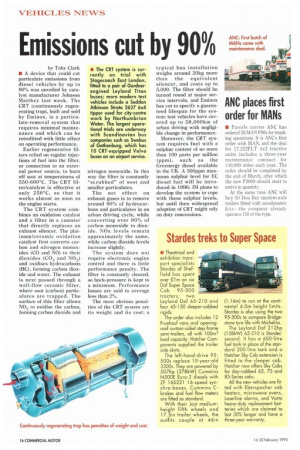Emissions cut by 90%
Page 18

If you've noticed an error in this article please click here to report it so we can fix it.
by Toby Clark • A device that could cut particulate emissions from diesel vehicles by up to 90% was unveiled by catalyst manufacturer Johnson Matthey last week. The CRT (continuously regenerating trap), built and sold by Eminox, is a particulate-removal system that requires minimal maintenance and which can be retrofitted with little effect on operating performance.
Earlier regenerative filters relied on regular injections of fuel into the filter, or connection to an external power source, to burn off soot at temperatures of 550-600°C. The CRT filter/catalyst is effective at only 250°C, so that it works almost as soon as the engine starts.
The CRT system combines an oxidation catalyst and a filter in a canister that directly replaces an exhaust silencer. The platinum/ceramic oxidation catalyst first converts carbon and nitrogen monoxides (CO and NO) to their dioxides (CO2 and NO2) and oxidises hydrocarbons (HC), forming carbon dioxide and water. The exhaust is next passed through a wall-flow ceramic filter, where soot (carbon) particulates are trapped. The surface of this filter allows NO2 to oxidise the carbon, forming carbon dioxide and nitrogen monoxide. In this way the filter is constantly "scrubbed" of soot and smaller particulates.
The net effect on exhaust gases is to remove around 90% of hydrocarbons and particulates in an urban driving cycle, while converting over 90% of carbon monoxide to dioxide. NOx levels remain approximately the same, while carbon dioxide levels increase slightly.
The system does not require electronic engine control and there is little performance penalty. The filter is constantly cleared, so back-pressure is kept to a minimum. Performance losses are said to average less than 2%.
The most obvious penalties of the CRT system are its weight and its cost: a typical bus installation weighs around 20kg more than the equivalent silencer, and costs up to 5,000. The filter should be turned round at major service intervals, and Eminox has yet to specify a guaranteed lifespan for the system: test vehicles have covered up to 58,000km of urban driving with negligible change in performance.
Moreover, the CRT system requires fuel with a sulphur content of no more than 100 parts per million (ppm), such as the Greenergy diesel available in the UK. A 500ppm maximum sulphur level for EC diesel fuel will be introduced in 1996; JM plans to develop the system to cope with these sulphur levels, but until then widespread adoption of CRT might rely on duty concessions.
































































































